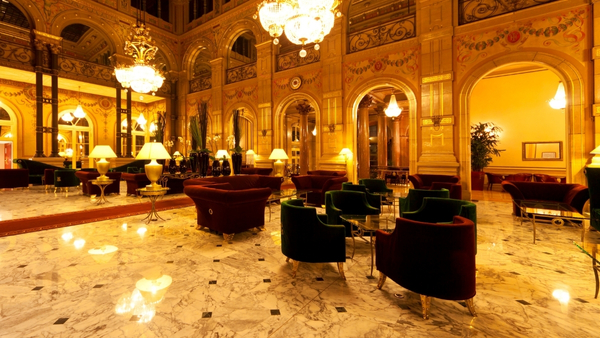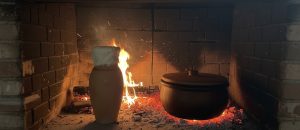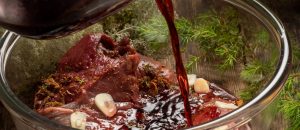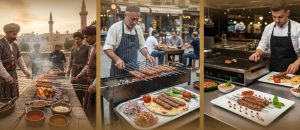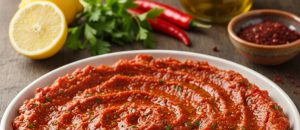Nestled along the winding Kızılırmak (Red River) in the heart of Cappadocia, the town of Avanos holds a profound secret, not just for its breathtaking landscape, but for a craft that has shaped Anatolian culinary history: pottery. This ancient art, passed down through millennia, finds its most exquisite expression in the clay vessels that give life to iconic dishes like Testi Kebabı. This in-depth article, a vital Cluster Content piece supporting our “Testi Kebabı: Anatolia’s Clay Pot Culinary Secret and Dance with Fire” Pillar Page, will embark on a fascinating journey. For food historians and culinary tourists alike, we will delve into the storied history of Avanos pottery, explore the unique properties of the Kızılırmak clay, meticulously detail the craftsmanship involved in shaping the “testi” pot, and uncover the deep, symbiotic connection between this ancient craft and Anatolia’s rich culinary culture. Join us as we explore Avanos, where earth, art, and gastronomy converge to create timeless masterpieces.
Earth’s Embrace, Artisan’s Hand: The Legacy of Avanos Pottery
Avanos pottery is far more than a simple craft; it is a living legacy that embodies the deep connection between the land, skilled artisans, and Anatolian culinary traditions. For millennia, the unique clay of the Kızılırmak River has been transformed by the hands of potters into functional and artistic vessels, profoundly influencing the region’s gastronomic identity.
More Than Clay: A Cultural and Culinary Tapestry
Avanos pottery weaves a rich cultural and culinary tapestry, impacting art, daily life, and the very flavors of Cappadocia.
- Artistic Heritage: The town is world-renowned for its unique, handcrafted ceramics, often featuring intricate designs and vibrant colors, representing an unbroken artistic tradition.
- Functional Beauty: Beyond aesthetics, Avanos pottery is deeply functional, with vessels designed for cooking, serving, and storage, making it an integral part of daily domestic life.
- Culinary Cornerstone: Specific pots, like the amphora-shaped “testi,” are indispensable for traditional dishes such as Testi Kebabı, demonstrating how the craft directly shapes the region’s culinary identity. The pots are not just containers but active participants in the cooking process.
- Economic Driver: The pottery industry in Avanos is a significant economic driver, sustaining families and local communities, and drawing tourists interested in traditional crafts.
- Cultural Symbolism: The clay, derived from the Kızılırmak, symbolizes a direct connection to the earth and the region’s ancient past, making the pottery a potent cultural symbol.
Our Journey: Unearthing Avanos’s Pottery Secrets
This article will embark on a journey to unearth the ancient secrets and intricate processes behind Avanos pottery, focusing on its culinary significance.
- Geological Origins: We will explore the unique properties of the Kızılırmak clay that make it ideal for pottery.
- Historical Timeline: Trace the long history of pottery in Avanos, from its Hittite origins to its modern master craftsmen.
- Crafting the Pot: Detail the step-by-step process of shaping, drying, and firing a “testi” pot.
- Culinary Link: Examine the symbiotic relationship between Avanos pottery and Testi Kebabı, highlighting how the vessel influences the dish.
- Preservation Efforts: Discuss how this ancient craft is sustained in the modern age through tourism and traditional teaching.
The Red River’s Gift: Geology and the Genesis of Avanos Clay
The very essence of Avanos pottery, and thus Testi Kebabı, begins with the unique geological bounty provided by the Kızılırmak (Red River), which has nourished the region’s clay deposits for millennia. This specific clay is not merely earth; it is a meticulously balanced blend of minerals that lend itself perfectly to the potter’s wheel and the rigors of culinary use.
Kızılırmak Clay: Unique Properties for Perfect Pottery
The red clay found along the banks of the Kızılırmak River possesses distinctive properties that make it exceptionally well-suited for high-quality pottery.
- Mineral Composition: The clay is rich in iron oxides, which give it its characteristic reddish hue after firing. It also contains a balanced blend of other minerals like silica and alumina. This specific composition contributes to its strength and durability.
- Plasticity: Kızılırmak clay is known for its excellent plasticity – its ability to be easily molded and retain its shape. This is crucial for potters using the wheel-throwing technique, allowing them to create intricate and precise forms like the narrow neck of a “testi.”
- Workability: The clay’s workability allows for fine detailing and robust construction, essential for vessels that need to withstand both the heat of an oven and the dramatic impact of being broken at the table.
- Low Shrinkage: High-quality pottery clay has relatively low shrinkage during drying and firing, which helps prevent cracking and warping, ensuring the integrity of the finished pot.
- Thermal Properties: After firing, the clay becomes surprisingly strong and exhibits good thermal shock resistance, making it suitable for direct heat exposure in traditional ovens and for containing hot stews. Its insulating properties, as discussed in our “Slow Cooking Science” article, are also vital for Testi Kebabı.
Ancient Roots: From Hittites to Modern Masters
The use of Kızılırmak clay for pottery in Avanos is a tradition that stretches back thousands of years, forming an unbroken lineage from ancient civilizations to today’s master craftsmen.
- Hittite Era (circa 17th-12th Century BCE): The Hittites, one of Anatolia’s most powerful ancient empires, were skilled potters and likely utilized the Kızılırmak clay. Archaeological findings in Central Anatolia include intricate Hittite pottery, some of which may have been crafted in areas with similar clay sources. This era established early, sophisticated pottery techniques.
- Phrygian, Lydian, Roman, Byzantine Influences: Subsequent civilizations that inhabited Anatolia continued and refined the pottery traditions, passing down knowledge and techniques. Each era left its mark on the styles and forms of ceramics produced in the region.
- Seljuk and Ottoman Periods: During the Seljuk and Ottoman empires, Avanos continued to be a significant center for pottery. Earthenware vessels were essential for domestic use, culinary preparations, and sometimes decorative arts, maintaining the continuity of the craft.
- Modern Masters: Today, Avanos is home to numerous workshops where master potters, many of whom are descendants of long lines of artisans, continue to use the same Kızılırmak clay and traditional techniques (like kick-wheels) that have been employed for centuries. This direct connection to ancient practices makes Avanos a living museum of pottery history.
Crafting the Testi: The Art and Process of Avanos Potters
The creation of a “testi,” the iconic clay pot used for Testi Kebabı, is a meticulous art form, demanding skill, patience, and a deep understanding of clay’s properties. The process, largely unchanged for centuries, transforms raw Kızılırmak clay into a durable, functional, and beautiful culinary vessel. This section delves into the step-by-step craftsmanship of Avanos potters.
Gathering and Preparing the Clay: From Riverbed to Wheel
The journey of a testi pot begins with the careful extraction and preparation of the raw clay from the Kızılırmak River, a process that ensures its quality and workability.
- Clay Sourcing: Potters traditionally source their specific red clay from deposits along the banks of the Kızılırmak River. The selection process is crucial, as not all clay is suitable for fine pottery.
- Cleaning and Processing: Once gathered, the raw clay is subjected to a thorough cleaning process. This involves:
- Soaking: The clay is soaked in large pools of water to dissolve impurities and separate out larger particles.
- Filtering: The watery clay mixture is then poured through fine sieves or filters to remove small stones, sand, and organic matter. This ensures a smooth, consistent clay body.
- Sedimentation: The fine clay particles settle at the bottom, and excess water is drained off.
- Kneading (Wedging): The cleaned clay is then kneaded vigorously (a process called wedging). This vital step serves multiple purposes:
- Homogenizing: It ensures a uniform consistency throughout the clay.
- Removing Air Bubbles: Air bubbles trapped in the clay can cause it to explode in the kiln during firing. Kneading removes these.
- Developing Plasticity: It aligns the clay particles, enhancing its plasticity and making it easier to work on the wheel. This prepared clay is then ready for the potter’s wheel.
Wheel Throwing and Shaping: The Iconic Testi Vessel
The heart of Avanos pottery lies in the ancient art of wheel throwing, where skilled hands transform a lump of clay into the distinctive amphora-shaped testi.
- The Potter’s Wheel: Avanos potters traditionally use a kick-wheel (ayak çarkı), powered by foot, allowing both hands to be free for shaping. This method requires immense skill and coordination, passed down through generations.
- Centering the Clay: The potter first “centers” a lump of clay on the spinning wheel. This crucial step ensures the clay is perfectly balanced, allowing for symmetrical growth.
- Opening and Pulling: The potter then opens a hole in the center of the clay and, using their fingers and thumbs, gradually “pulls” the clay upwards and outwards, forming the basic cylinder.
- Shaping the Body: The body of the testi is shaped into its characteristic bulbous, round form, designed to hold a generous amount of meat and vegetables.
- Creating the Neck: The defining feature of the testi is its narrow, tall neck. This requires particular skill to pull upwards from the body, ensuring it is sturdy enough to be sealed with dough and later broken. The narrow neck is not just aesthetic; it’s functional for the Testi Kebabı cooking process.
- Finishing Touches: Once the basic form is thrown, the potter may refine the shape, smooth the surface, and trim any excess clay. Each testi, while adhering to the traditional form, often carries the unique touch of the individual artisan.
Drying and Firing: Transforming Clay into Durable Cookware
After shaping, the clay pots undergo critical drying and firing stages, which chemically and physically transform them into durable, functional cookware.
- Drying (Leather-Hard to Bone Dry):
- Initial Drying: The freshly thrown pot is allowed to dry slowly and evenly in the air, usually in a shaded, well-ventilated area. This initial stage is crucial to prevent warping or cracking.
- Leather-Hard Stage: As it dries, the clay reaches a “leather-hard” stage, where it’s firm enough to be handled and trimmed but still retains some moisture.
- Bone Dry Stage: The pot must become completely “bone dry” before firing. All residual moisture must evaporate, as trapped water can turn to steam and cause the pot to explode in the kiln.
- Firing (Bisque Firing):
- Traditional Kilns: Traditionally, Avanos potters use large, wood-fired kilns, often built into caves or underground, which provide stable and intense heat.
- Temperature: The pots are fired at very high temperatures, typically ranging from 900°C to 1100°C (1650°F to 2000°F).
- Chemical Transformation: Firing is a permanent chemical and physical transformation. The intense heat vitrifies the clay (melts silica particles), making it hard, durable, and non-rehydratable. This process gives the pot its strength and makes it suitable for culinary use.
- Unglazed Finish: Most testi pots remain unglazed (or only partially glazed on the exterior for decoration). This unglazed, porous surface is essential for its unique moisture-absorbing and self-steaming properties, crucial for Testi Kebabı.
- Quality Control: After firing, pots are inspected for flaws. Only perfect, durable vessels are selected for culinary use, ensuring safety and performance for dishes like Testi Kebabı.
The Culinary Connection: Avanos Pottery and Testi Kebabı
The deep, symbiotic relationship between Avanos pottery and Anatolian cuisine, particularly Testi Kebabı, highlights how specialized cooking vessels are not merely containers but active participants in the culinary process. The unique design and properties of the Avanos testi pot are intrinsically linked to the distinct characteristics and appeal of Testi Kebabı.
Testi Kebabı’s Vessel: Designed for Slow, Sealed Perfection
The specific design and unglazed nature of the Avanos “testi” pot are perfectly engineered for the unique slow-cooking process of Testi Kebabı.
- Narrow, Sealable Neck: The tall, narrow neck, which is sealed with dough, is the defining functional feature. This creates an airtight and slightly pressurized environment during cooking, trapping steam and volatile aromatics. This internal pressure helps tenderize meat by forcing moisture and flavor into the fibers.
- Bulbous Body: The wide, bulbous body provides ample space for meat and vegetables to cook gently and evenly in their own juices. The large volume-to-surface area ratio helps maintain a consistent, moderate temperature throughout the cooking process.
- Unglazed Porosity: The unglazed, porous clay, when soaked before use, absorbs water. This absorbed water slowly releases as steam during cooking, contributing to the self-steaming, moist-heat environment that is crucial for Testi Kebabı’s tenderness and flavor concentration.
- Thermal Insulation: As discussed in “Slow Cooking Science,” clay’s excellent thermal insulation ensures slow, even heat distribution, which is ideal for breaking down collagen in tough cuts of meat into succulent gelatin.
- Dramatic Presentation: Beyond function, the design facilitates the dramatic tableside breaking ritual, turning the meal into an unforgettable sensory and cultural experience.
Beyond Testi: Other Culinary Uses of Avanos Ceramics
While Testi Kebabı is iconic, Avanos potters produce a range of other ceramic vessels that serve various culinary purposes in Anatolian kitchens.
- Güveç (Casserole Pots): Wider, shallower, or deeper lidded clay pots, known as “güveç,” are commonly used for a variety of slow-cooked stews and baked dishes (like vegetable güveç or meat güveç). These also benefit from clay’s heat retention and moisture-regulating properties.
- Serving Bowls and Plates: Decorative and functional ceramic bowls and plates from Avanos are used for serving mezes, salads, and other dishes, adding an aesthetic dimension to the Turkish dining table.
- Storage Jars (Kavanoz): Larger clay jars were historically and are still sometimes used for storing preserved foods like pickles, olives, or even grains, benefiting from clay’s ability to maintain a relatively stable temperature and humidity.
- Coffee Pots (Cezve): Smaller, finely crafted clay cezves (Turkish coffee pots) were also traditionally used, highlighting the versatility of the craft.
- Cultural Integration: These diverse culinary applications underscore how Avanos pottery is not just a craft but is deeply integrated into the daily culinary practices and cultural identity of the region, providing essential tools for a wide array of Anatolian dishes.
Preservation and Future: Avanos Pottery in the Modern Age
In an era of mass production and globalized markets, the ancient craft of Avanos pottery faces both the imperative of preservation and the opportunities of adaptation. Maintaining this millennia-old tradition, deeply intertwined with culinary heritage like Testi Kebabı, requires a strategic approach that embraces cultural tourism, addresses modern challenges, and ensures the craft’s continued relevance.
Cultural Tourism: Workshops and the Living Tradition
Cultural tourism has emerged as a vital lifeline for Avanos pottery, transforming workshops into living museums where visitors can engage directly with the craft.
- Visitor Experience: Avanos pottery workshops are a major attraction in Cappadocia. Tourists are not just observers; they are often invited to participate in hands-on experiences, attempting to throw clay on the potter’s wheel under the guidance of a master. This direct engagement fosters appreciation and understanding.
- Direct Economic Support: Tourist visits and direct purchases provide essential economic support to local potters, allowing them to continue their craft without relying solely on larger, more competitive markets.
- Educational Value: These workshops serve as invaluable educational centers, preserving and transmitting traditional knowledge about clay, techniques, and the cultural significance of pottery. Potters share their stories, bridging the past and present.
- Promoting Testi Kebabı: The connection between Avanos pottery and Testi Kebabı is a significant draw. Many workshops collaborate with local restaurants, creating a holistic experience that links the craft of the pot to the culinary delight it produces, further enhancing the appeal of both.
- Global Awareness: Tourism brings global awareness to Avanos pottery, showcasing its unique artistry and historical depth to an international audience, ensuring its place on the world stage of traditional crafts.
Sustaining the Craft: Challenges and Opportunities
Despite the benefits of tourism, Avanos pottery, like many traditional crafts, faces challenges in the modern era, but also possesses opportunities for sustainable growth and innovation.
- Challenges:
- Competition: Mass-produced, cheaper ceramics pose a significant challenge to handcrafted pottery, making it difficult for artisans to compete on price.
- Aging Workforce: The demanding nature of the craft and the allure of more lucrative or less physically strenuous professions can lead to an aging workforce and a reluctance among younger generations to pursue pottery.
- Resource Management: Sustainable management of the Kızılırmak clay resources is important to ensure the long-term viability of the craft.
- Marketing and Distribution: Traditional artisans may struggle with modern marketing, branding, and distribution channels to reach wider markets beyond local tourism.
- Opportunities:
- Niche Markets: Targeting niche markets that value authentic, handcrafted, and culturally significant products (like Testi Kebabı pots) can command premium prices.
- Modern Design Integration: Collaborating with contemporary designers to create modern pieces that incorporate traditional techniques can expand market appeal while honoring the craft.
- Digital Presence: Utilizing e-commerce platforms and social media can help Avanos potters reach a global audience directly, bypassing traditional intermediaries.
- Apprenticeship Programs: Establishing formal apprenticeship programs and vocational training can ensure the transfer of skills to younger generations, safeguarding the craft’s future.
- Certification and Branding: Developing a “Made in Avanos” certification or brand can further differentiate authentic Avanos pottery and protect it from imitations, similar to geographical indications for food.
Avanos Pottery – Where Art, Earth, and Gastronomy Converge
Our journey through “Avanos Pottery: Crafting the Culinary Vessel of Cappadocia” reveals a profound tapestry where the ancient art of pottery, the geological bounty of the Kızılırmak, and the rich gastronomy of Anatolia beautifully converge. We’ve explored the unique properties of Avanos’s red clay, meticulously traced its history from Hittite times to modern masters, and delved into the intricate, age-old processes of crafting the iconic “testi” pot. This vessel is not merely a container; it is an active participant in culinary magic, intrinsically linked to the tenderness and concentrated flavors of Testi Kebabı, and symbolizing the deep connection between the earth and our nourishment. In the modern age, cultural tourism and dedicated artisans strive to preserve this living tradition, facing challenges yet embracing opportunities to ensure its enduring legacy. Avanos pottery stands as a timeless testament to human ingenuity and artistic heritage, a place where the artisan’s hand molds earth into art, and that art in turn shapes the very flavors of Anatolian culture, creating masterpieces that delight both the eye and the palate.


